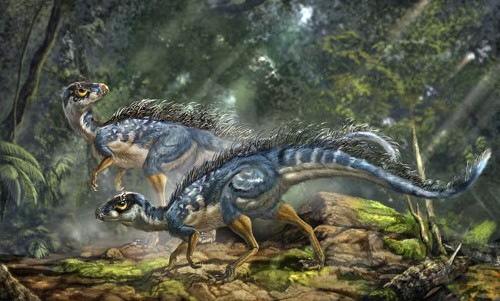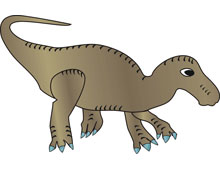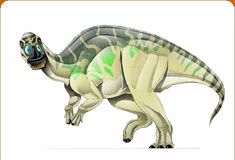Welcome to the first ever
ART Evolved internet art carnival! Here on known as a
gallery, or as per the theme of this site a "time-capsule".
We are proud to present the contributions of not only the new ART Evolved blogging team, but also submissions from many other palaeontology enthusiasts.
_
Now as this is our first ever such gallery, and strict deadlines and/or cut offs would take the fun out of all this (as this is supposed to be nothing but fun!), we will be accepting and posting late entries whenever they should turn up. So be sure to check back every now and then to see what new pieces have popped up.
_
Also for those of you who wish to add something to the so far rather impressive collection (which should only be made more impressive with your entry)
you still can! Send them to
artevolved@gmail.com with a title and desired text blurb, and we'll get them up as soon as we can!

So the
Ceratopsians. To start off with they were of course Dinosaurs, a family from the
Ornithischian branch of the
Dinosaurian lineage.
_
The Ceratopsians are most famous for many of their later members having impressive eye and nose horns coupled with spectacularly large shield-like frills. This was not always the case, and many did not have the horns and/or the frill. They all however had beaks which were a special bone called a rostral at the front of their jaw that no other animal has ever had! This is the key feature unifying the Ceratopsians, and the one palaeontologists use to i dentify them.
_
Ceratopsians are generally thought of to have been herbivores, but a few scientists have recently suggesting there is a chance some of them were omnivores... Meaning there could be a major overhaul on how we view these animals if they are right!
_
The Ceratopsians had a fairly late start for a major group of Dinosaurs at around 175-170 million years ago in the mid-Jurassic, but they lasted till the very end of the Dinosaurs reign 65 million years ago. They started off clearly in Asia, but as time progressed they radiated into North America, and possibly into Gondwana (Australia and South America have very partial Ceratopsian-like remains, but not enough to be certain one way or another).
_
So let us now look into this time capsule from the Mesozoic to see what could have been...
There is no real consensus on what this monsterlooked like, but one popular theory suggests that the huge bony terraceon its nose was the base of a huge horn or group of horns make ofkeratin - there's no evidence of the actualy horns, but if they were real, it would look like a Tyrannosaur's worst nightmare. The Royal Tyrell museum of Alberta has two statues of the speculative mega-horned Pachyrhinosaurus, so I decided to just go wild with this one and NOT stick to only the bones.
I drew this herd of Styracosaurus albertensis for thenewest issue of Prehistoric Times, which should be out soon. This isonly on an 8.5 x 11" paper and it took almost a month. A starkly patterned male faces down a predator (yeah, it's YOU!) while the rest of the clan heads to the river.


The centrosaurines form a subfamily of the Ceratopsidae. Most have ornate, fenestrated frills, and the skulls are all fairly well-known. Albertaceratops is the most recently discovered, with beasts like Styracosaurus being relatively well-known amongst dinosaur fans.


A lovely Pachyrhinosaurus canadensis. It's name is taken from the pages of Tolkien, a reference that is quite appropriate indeed.


 Psittacosaur Fleshed Out by Sean Craven
Psittacosaur Fleshed Out by Sean Craven

 The Perfect Dinner! by Traumador the Tyrannosaur
The Perfect Dinner! by Traumador the Tyrannosaur
In his piece of "modern art", the world's smallest (and most alive!) T-Rex gives us a theropod's point of view on the horned dinosaurs. Not really all that unexpected I guess.


Einiosaurus growth series by Zach Miller
The juvenile is based on Brachyceratops montanensis (Gilmore, 1917), and the subadult is, of course, a modified Monoclonius lowei (Sternberg, 1940). The adult is based mostly on Sampson (1995) but parts (mostly the frill) are taken from Carpenter (in Dodson, 1996). Species thanks go out to Andrew Farke for checking my work and sending me a ton of papers about centrosaurine ontogenetic development.
Now, let's talk about the piece itself. I was interested in showing a growth series of a centrosaurine ceratopsid because, frankly, they go through some significant changes.
Einiosaurus barely goes through anything compared to Pachyrhinosaurus, of course (Currie, et al. 2008). Awhile back, I remember seeing a painting of a drowning centrosaurine that was described as a "new species of Styracosaurus." I realize now that it was Einiosaurus, but the painting was from long ago. I could've sworn it was in the old Dinosaurs: Past and Present series, but I looked through both volumes and couldn't find the picture.
Einiosaurus is interesting it seems to represent the second step in a transitional series between Styracosaurus albertensis and Pachyrhinosaurus canadensis. Scott Sampson suggests that the encroachment of the Bearpaw Sea sparked a bit of an evolutionary revolution among Alberta and Montana's residents, including tyrannosaurs and hadrosaurs.
The picture is also something of an achievement for me in that, aside from the initial sketches, everything you see here is digitally created with the help of my laptop, Wacom Bamboo "Fun" tablet, and Scott Elyard. The colors were unbelievably hard to decide on. In fact, the keen observer will note a complete lack of hue on the necks, because I couldn't decide on a good companion color the head maroon heads.
In addition to the growth (and reabsorbtion) of the horns and spikes, I've darkened the colors of the beak and horny sheaths as the animal ages. Were I to rework this picture in the future, I'd put some color on the necks and maybe toss a light background color in there. Ah, work for another day, I suppose.
References:
Gilmore, C. W. (1917). Brachyceratops, a ceratopsian dinosaur from the Two Medicine Formation of Montana with notes on associated reptiles. US Geological Survey Professional Paper 103: 1-45.
Sternberg, C. M. (1940). Ceratopsidae from Alberta. Journal of Paleontology 14: 468-480.
Sampson, S. (1995). Two new horned dinosaurs from the Upper Cretaceous Two Medicine Formation of Montana; with a phylogenetic analysis of the Centrosaurinae (Ornithischia: Ceratopsidae). Journal of Vertebrate Paleontology 15: 743-760.
Dodson, P. (1996). The Horned Dinosaurs. Princeton University Press: Princeton, New Jersey.
Currie, P. J. Langston, Jr., W., & Tanke, D. H. (2008). A New Horned Dinosaur From an Upper Cretaceous Bone Bed in Alberta. NRC Research Press: Ottawa, Canada.

Inspired by
the recent theory that the short frilled
centrosaurids likely did not use their nasal horns in combat (unlike the long frilled
chasmosaurids), here we have a pair of male
Styracosaurus albertensis locking their frill horns and pulling against each other in a show of strength.
Though the recent paper purposing the difference between the two families suggests that the centrosaurids probably just competed against each other visually, I took the liberty of guessing an alternate route the Styracosaurus may have gone due to the crazy number of horns protruding off its head! You'll also note my conjectural quill projections on their tails inspired by Psittacosaurus'.
This piece was built entirely in 3D (forest and Dinosaurs), and than run through a rendering filter called TOON. The idea was to get a cartoon looking picture. The results aren't what I wanted at all, and I'm aiming play with it some more, but it was neat so I threw it in anyway.



This curious critter was among the last of the great dinosaurs before the K-T extinction, and probably one of the world's most familiar, indeed synonymous with the word "dinosaur" to the average person. A great muscled hulk that seems part parrot, part angry, scaly cow, with a curious array of weaponry and sheilding. Apart from the large bony frill that did well at protecting the herbivore's jugular, Triceratops also sported several hard, bony scutes, impressions of which have been found in some fossil formations.


Two former foes from Montana meet again for the first time in 65 million years for a classic Cretaceous confrontation. (Science Museum of Minnesota, AMNH).

Oil and digital, 2009. Title and concept inspired by
Chasmosaurus, one of the
ceratopsians. Glendon has blogged on the
'making of' this piece here.

A long time ago, when I was still doing steady work for the Alaska Museum of Natural History (it's rare now), I was asked to draw two cartoony pictures showing how an Alaskan dinosaur might make produce a fossil skin impression. A short flurry of concepts resulted in this happy little Pachyrhinosaurus taking a mud bath. The picture was never used, unfortunately, but it remains one of my personal favorites.



This diagram shows the current thinking of the relationships between the members of the Centrosaurinae. There are two clear groups, and two that don't fit in. Avaceratops is believed to be the most basal member of this subfamily.



Psittacosaur Creche by James Robins 

While there is no direct evidence (and little supporting evidence) that Psittacosaurus sibiricus was either a) a quadraped or b) a digging animal, there is this fascinating proto-ceratopsid with a knobby skull, reminiscint of the warthogs of modern Africa, who do indeed dig mud wallows and root for tubers and roots. And with new evidence supporting that these dinosaurs were more "rotund" than previously hypothesized, the image sticks in my mind of this little pig-bodied, parrot-beaked reptile, studiously pawing the Early Cretaceous subtropical regions that are now Western Siberia, in search of roots, tubers, or a place in the mud to cool off.

The adult bull began life as a skull restoration, as do most of my dinosaur drawings. The squamosal-parietal contact isn't exactly right, which I tried to fix in the final version.
Notice, of course, that the fossil skulls lack horns between the anterior base of the nasal horn and the rostrum. I tossed a "rostral comb" in because I figured that horn growth wouldn't just stop when the male reached a certain age. In modern horned ungulates, the horns keep growing throughout life. In dall sheep, the horns keep spiraling until death.
My philosophy with centrosaurines is that horn growth would continue like a sort of plague, with bumps and spikes appearing in more and more places with age, hence the little Pachyrhinosaurus-like triple spike on the center of the parietal.

A herd of Pachyrhinosaurus lakustai hit a fateful obstacle when they try to get across a flooding river. Some would survive, some would not. The rest is, well, shall we say Prehistory...
This piece was a two step effort. The first was creating the flood waters in an otherwise tranquil picture of a river bed. With the new raging river in place, ten 3D rendered Dinosaurs then had to be posed and positioned in relation to the photo, and than have splashs and trees composited back over top of them to integrate all the elements together.
Watch for a making of it here on ART Evolved in a week's time!

Diabloceratops eatoni, a recently discovered/described centrosaurine from the Late Cretaceous of Utah. Pen and color pencil on paper.

Protoceratops by Vasika Udurawane

That sadly does it for our first time-capsule. Yet do not fear. We are opening a new one in two months time. So not only be sure to check back on May. 1st, but also please consider...

Set your pencils, pens, markers/felts, pencil crayons, charcoal, pastels, paints and brushes, clay, metal, pipe cleaners, paper
mache, and/or computers to the task of recreating one of the most interesting and bizarre relatives of all us modern day mammals.
The Synapsids, aka the
proto-mammals, mammal-like reptiles, or stem-mammals.
We shall be putting up a post in a couple weeks time to help you out with some ideas of not only what sorts of animals were in this group, but also how
palaeo-artists have previously tackled them.
Can't wait to see your submissions for it!

 Not that the art, by Steve Uy, within is promising to be particularly scientifically accurate. Or for that matter of an "intelligent" nature, but man it is shaping up to be both pretty and fun! Especially if you're into Dinosaur related property destruction and mayhem like myself!
Not that the art, by Steve Uy, within is promising to be particularly scientifically accurate. Or for that matter of an "intelligent" nature, but man it is shaping up to be both pretty and fun! Especially if you're into Dinosaur related property destruction and mayhem like myself! 


 Dr. Naish of the legendary
Dr. Naish of the legendary  Glendon the Flying Trilobite, in this week's edition of his usual
Glendon the Flying Trilobite, in this week's edition of his usual 
 Dr. Ryan of the infamous
Dr. Ryan of the infamous 

 Finally, Craig the
Finally, Craig the 
















 Looking through my many lovely pictures of the New Zealand landscape (it is such a great place to sub in for a
Looking through my many lovely pictures of the New Zealand landscape (it is such a great place to sub in for a 


 So having a 3D Dinosaur model is only a part of the battle. Next came the long process of duplicating multiple animals from the original, tweaking and individualizing them, posing them, and finally repositioning these in relation to the picture.
So having a 3D Dinosaur model is only a part of the battle. Next came the long process of duplicating multiple animals from the original, tweaking and individualizing them, posing them, and finally repositioning these in relation to the picture.

 Giving me this as my end product.
Giving me this as my end product.


































 Set your pencils, pens, markers/felts, pencil crayons, charcoal, pastels, paints and brushes, clay, metal, pipe cleaners, paper
Set your pencils, pens, markers/felts, pencil crayons, charcoal, pastels, paints and brushes, clay, metal, pipe cleaners, paper